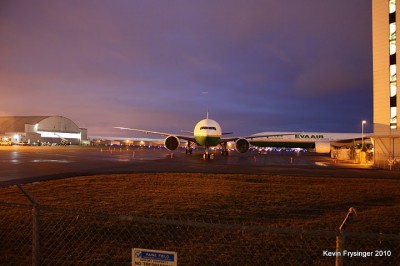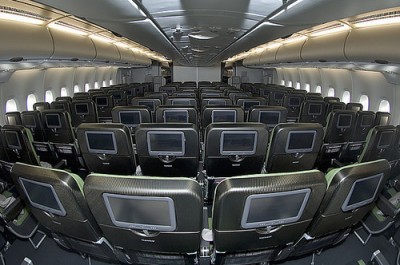
This is back in January when there were just two Eva Air Boeing 777-300ER's sitting at Paine Field. Photo by Kevin Frysinger
I am up at Paine Field quite a bit. This is where many of Boeing’s aircraft are made: the 777, 787, 747 and 767. For months I have seen two brand new Eva Air Boeing 777-300ER’s sitting by the control tower. The last time I went by, there were three. Why would Eva Air let three brand new planes worth about $800,000,000.00 just sit and not make revenue? Well, it turns out they have no seats and the problem extends beyond Eva Air.
The seat manufacturer Koito, based in Japan, falsified safety test results and in September of 2009, the European Aviation Safety Agency (EASA) withdrew approval for the seats. EASA claimed that 16g, 9g and flammability test data were affected and the EASA stopped Airbus from installing any additional seats.
Flight Global and ATI reports that these falsified tests affected as many as 150,000 seats on 1,000 aircraft. How can this happen? Multiple sources have confirmed to Flight Global and ATI that Koito falsely indicated that some seats had been cleared by the Japan Civil Aviation Bureau (JCAB) by illegally forging the JCAB’s stamp of approval.
Many airlines have had to deal with the delays of aircraft delivery due to Koito’s issues and yet there are even more airlines that already have the seats installed. Earlier, Boeing sent people to Japan to help Koito solve its quality issues. However, it seems that their help wasn’t enough and Boeing told me they will no longer offer Koito seats to customers.
I also asked Boeing if the seats already on airlines are safe and Bev Holland, Boeing Manufacturing & Quality Communications Specialist, explained, “Boeing has a comprehensive system in place to make sure seats conform to FAA specifications before being installed. While we are working to help those customers who have previously ordered Koito seats to make sure the seats are correctly installed and certified, Koito seats are no longer an option for new orders. ”
When I asked Boeing about the Eva Air Boeing 777’s, Holland stated, “we do not discuss our customers’ airplanes,” but she did confirm that, “seats are buyer-furnished equipment.”
I can respect Boeing not talking on behalf of an airline, so I went to talk to Eva Air. I was looking to see if Eva would confirm why the Boeing 777’s are not being used, what their game plans for the aircraft are and if they are paying parking fees to Paine Field (which is actually owned by Snohomish County). I heard back from Katherine Ko, Jr Vice President of Public Relations for Eva and she stated, “Our priorities are safety and quality service, and those aircraft are there for aircraft update.” I was hoping for a bit more information, but I can understand the airline not wanting to say too much publicly right now, especially if any legal action is taken in the future.
Since Boeing and Airbus are no longer providing the seats, are the ones currently flying safe? I am told they are safe and it has not proven that they are not, it has just been proven that Koito falsified records. Currently there is an advisory board made up of the JCAB, Airbus, Boeing, All Nippon Airways, Japan Airlines, and Koito determining if the seats are safe. The board is requesting airlines who currently fly with Koito seats to donate a few, so testing can be done to see if they are safe. I am not sure how well that will go. I know airlines care about the safety of their passengers but do they really want to donate seats that might help to determine if they are defective and need to be replaced?
I also wondered why the Federal Aviation Administration (FAA) wasn’t more involved in this matter since there are quite a few Koito seats flying in the United States. Would the FAA issue an Airworthiness Directive (AD) requiring all US airlines to replace the seats? I contacted them to find out and got some surprising answers.
I communicated with Alison Duquette, who is with the FAA Office of Communications, about the certification of the seats and she told me, “The Koito seats were approved through the US/Japan bilateral agreements. The JCAB reviews and accepts all data and the FAA then accepts their test data via our bilateral agreement.” This means the FAA just rubber-stamps JCAB’s approval, which was falsely rubber-stamped by Koito. Pushing to see if the FAA might possibly issue an AD she explained, “Japan is the certifying authority so they would be the government to issue a directive and then the FAA could follow.”
I asked the FAA if any new rules have been put into place after this incident and Duquette told me, “The JCAB has a process in place to make sure to correct any problems.” When I asked what the FAA thought about the forged approval by Koito, in essence by-passing the JCAB approval, Duquette referred me to the JCAB. At this point, it seems the FAA is taking a very hands-off approach.
So, what now? I am not exactly sure. Do I want the industry to have to spend millions during a time when they really cannot afford it? Of course not. However, I don’t want it to take an accident and people needlessly getting injured or die because they were sitting in faulty seats. I am sure this will be an on-going story. At the time of publishing this blog, I have not been able to get in contact with the JCAB or Koito. I will continue to work with Mary Kirby with Flight International (she also writes the RunwayGirl blog) on finding more answers.
No matter what happens, I really hope that those Eva Air Boeing 777’s can get into the sky soon; it is a shame seeing those beautiful birds stuck on the ground.
Image by @TxAgFlyer